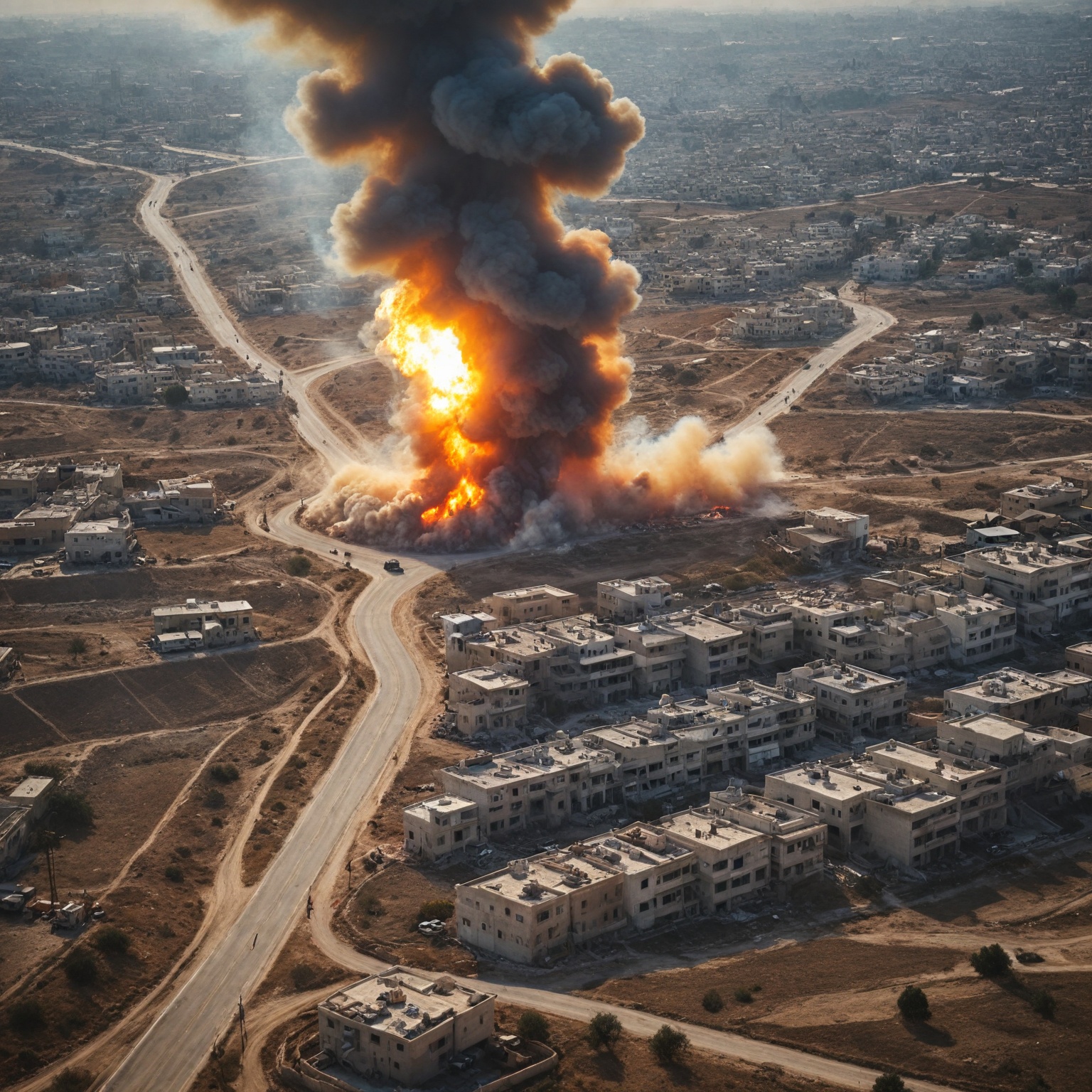Summary
The surge in U.S. crude oil prices by over 8% in late 2024 is primarily linked to escalating military tensions in the Middle East following Israeli military actions in Gaza and the broader region. This sharp price increase reflects market fears that the conflict could disrupt oil supplies, particularly through potential Israeli strikes on Iranian oil production and export facilities, which collectively account for over a million barrels per day. The volatility in oil prices was further driven by intensified hostilities involving key regional actors, including Iran, Hezbollah, and Hamas, as well as heightened concerns over a wider regional war.
The Israeli military response began after the Hamas attack on October 7, 2023, and has involved extensive airstrikes, ground operations in Gaza, and targeted actions against Iranian and Hezbollah interests. The conflict has expanded to Israel’s northern border with Lebanon and triggered a series of missile and drone attacks, many intercepted by Israeli defenses with U.S. support. Despite warnings from Iranian leaders about crossing “red lines,” Israel’s strategy has so far avoided direct strikes on Iranian oil infrastructure, focusing instead on military and cyber operations against nuclear and missile programs.
This geopolitical instability has had significant but measured impacts on global energy markets. Brent crude prices rose to $80 per barrel for the first time since mid-2023 amid concerns about supply disruptions and the strategic importance of Middle Eastern oil exports, particularly through the Strait of Hormuz. However, analysts and institutions such as the International Energy Agency emphasize that, to date, there have been no direct interruptions to oil supplies, and market fundamentals—such as OPEC+ production decisions and existing inventories—have helped temper price spikes despite ongoing volatility.
The crisis underscores the complex interplay between Middle Eastern geopolitics and global energy security. The United States continues to provide substantial military aid to Israel, while regional powers and international stakeholders remain engaged in efforts to prevent escalation. The potential for further conflict involving Iran poses a persistent risk to oil market stability, making this a critical issue for energy policy and international diplomacy moving forward.
Background
The surge in U.S. crude oil prices by over 8% is largely attributed to escalating military tensions in the Middle East, particularly following Israeli military actions in Gaza and the broader region. On the day of the price jump, both major crude benchmarks experienced gains exceeding 5%, driven by market fears of a potential Israeli strike on Iranian oil production and export facilities, which could disrupt over a million barrels per day of supply. These concerns were intensified by statements from Israeli and U.S. officials, as well as regional dynamics involving key players such as Iran, Hezbollah, and Hamas.
Since the outbreak of hostilities on October 7, 2023, violent incidents linked to the Israel-Hezbollah conflict have fluctuated between 150 and 250 per week, with a notable increase to over 280 incidents per week by late August 2024, largely due to intensified Israeli attacks. The ongoing conflict has not only heightened fears of a broader regional war but also raised the risk of attacks extending beyond Gaza and Israel. Iranian President Ebrahim Raisi warned that Israel’s military operations had crossed “red lines,” potentially prompting a wider regional response, with Iran maintaining its alliances with Hamas and Hezbollah.
Market reactions to these developments have been significant. Brent crude oil prices surged to $80 per barrel for the first time since summer 2023 following comments by U.S. President Joe Biden, despite disruptions in global shipping caused by Iranian-backed Houthi attacks in the Red Sea having a more limited immediate effect on prices. Analysts remain cautious about the likelihood of a direct Israeli strike on Iranian oil infrastructure, noting that while such an attack would escalate the conflict dramatically, Israel may prefer to limit its response to military or cyber operations targeting Iranian military sites rather than oil facilities.
The broader geopolitical context also influences oil market dynamics. Iran, as a major OPEC+ producer exporting approximately 1.3 million barrels per day mainly to China, plays a crucial role in global oil supply. Consequently, any disruption to Iranian exports due to escalating conflict would have far-reaching impacts on oil prices worldwide. Meanwhile, regional actors such as Gulf Cooperation Council (GCC) states, including Saudi Arabia, the United Arab Emirates, Bahrain, and Kuwait, which host U.S. military bases, have been closely monitoring the situation, seeking to prevent the conflict from expanding further across the Middle East.
In addition, international stakeholders such as Russia, China, and European countries are expected to influence future negotiations related to Iran’s nuclear program and regional stability, potentially shaping the trajectory of the conflict and its impact on global energy markets. The interplay of these factors contributes to the volatility and sensitivity of crude oil prices amid the ongoing Middle Eastern conflict.
Israeli Military Actions
In response to the Hamas attack on October 7, 2023, which involved a multi-faceted surprise assault on over 20 Israeli communities, the Israel Defense Forces (IDF) launched extensive military operations aimed at neutralizing Hamas capabilities and rescuing hostages abducted to Gaza. The initial ground incursions into the Gaza Strip involved armored vehicles and infantry tasked with targeting Hamas fighters in temporary raids rather than a full-scale invasion. These operations intensified over subsequent weeks, with Israel increasing aerial strikes and ground troop deployments along the Gaza border.
The IDF faced a barrage of approximately 180 missiles fired from Iran toward Israel, most of which were intercepted, though some missile hits were recorded. This escalation further complicated the conflict, prompting Israel to consider potential counterstrikes targeting Iranian oil facilities, nuclear sites, or energy infrastructure. Israeli Prime Minister Benjamin Netanyahu publicly confirmed targeted strikes against Iran’s nuclear and ballistic missile programs, including attacks on the Natanz enrichment site and key Iranian military personnel, marking a significant shift in the ongoing shadow conflict between the two nations.
On the northern front, the conflict extended to Israel’s border with Lebanon, where Israeli forces escalated operations against Hezbollah as part of “Operation Northern Arrows,” involving sabotage and targeted strikes against Hezbollah communications and personnel. The broader regional tension was highlighted by statements from US and Iranian officials, with warnings of a potential wider conflict involving multiple countries in the Middle East.
Within Gaza, Israeli military strategies evolved in response to Hamas’s shift back to guerrilla tactics, employing hit-and-run attacks and operating in smaller cells to prolong resistance. Israeli public support for the military campaign remained strong, with polls indicating that a vast majority of Jewish Israelis backed the war effort against Hamas. Despite diplomatic efforts that led to a cease-fire mediated by the United States, Egypt, and Qatar in early 2025, hostilities resumed with renewed Israeli offensives across Gaza’s major population centers, including Gaza City, Khan Yunis, and Rafah.
The conflict imposed substantial economic and security costs on Israel, with war-related expenses estimated at approximately NIS 180 billion through 2024, excluding American aid. Additionally, Iran’s Islamic Revolutionary Guard Corps warned of retaliatory strikes against Israeli energy installations should Israel target Iranian energy infrastructure, underscoring the high stakes involved in the regional escalation.
Impact on US Crude Oil Prices
The recent Israeli military actions and escalating tensions in the Middle East have significantly influenced US crude oil prices. Following President Biden’s remarks, the price of Brent crude—the global benchmark—rose to $80 per barrel for the first time since the summer, marking a notable surge in the market. This increase reflects growing concerns over potential disruptions in oil supply stemming from conflicts involving Iran and its proxies, particularly given Iran’s role as a supplier of up to 4% of global oil.
Despite these concerns, the oil market has shown a degree of restraint, with many analysts suggesting that the recent military actions are unlikely to trigger a severe escalation that would drastically impact oil supplies. Citi analysts, for instance, lowered their Brent crude forecast to $70 per barrel over the coming months, reflecting a more cautious outlook despite the geopolitical risks. This tempered response is partly attributed to the relatively low probability of a direct Israeli attack on Iranian oil infrastructure, which would have more profound effects on global oil flows.
Nonetheless, the possibility of a broader conflict involving Iran—a major oil producer—has contributed to increased volatility and price spikes. Experts warn that a sharp escalation could lead to a significant oil price shock, which would not only elevate gasoline prices but also exert inflationary pressures across various manufacturing sectors reliant on petroleum products. Indeed, oil prices surged approximately 1.5% on the day following heightened conflict and have climbed more than 8% over a two-week period amid intensified hostilities.
Market reactions have also been influenced by the strategic importance of the region and ongoing threats, including Iranian-backed missile and drone attacks against Israel. However, Israel’s successful interception of the majority of these projectiles, with support from US forces, has so far prevented a broader disruption. Unlike the dramatic price spikes observed during prior crises such as the Russia-Ukraine war in early 2022, when Brent crude reached over $139 per barrel due to extensive supply concerns, current price movements remain comparatively moderate.
Further complicating market dynamics are factors such as OPEC+ supply adjustments and macroeconomic uncertainties, which have mitigated the potential for a more pronounced rally despite geopolitical tensions. The International Energy Agency has noted that the conflict has not directly disrupted oil supplies yet, contributing to the current restrained market reaction. Nonetheless, analysts caution that low global oil inventories mean prices are likely to remain elevated until the situation stabilizes.
Economic and Market Implications
The recent Israeli military actions have introduced significant uncertainty into global energy markets, yet the anticipated drastic disruptions have not fully materialized. Despite intense conflict in the Middle East, including missile strikes and ground engagements involving Israel, Hamas, Hezbollah, and direct confrontations with Iran, oil markets have demonstrated relative resilience. Crude oil prices, including benchmarks like Brent and West Texas Intermediate (WTI), have experienced fluctuations but remain below levels seen in previous years, reflecting a muted market reaction to geopolitical tensions.
Several factors contribute to this tempered market response. The prevailing fundamentals of oil supply and demand, such as the substantial production levels maintained by key producers including Iran and Libya, have helped stabilize the market. Iran’s output, operating under U.S. sanctions, reached a five-year high of over 3 million barrels per day in 2023, while Libya contributed approximately 1.3 million barrels per day, supporting global supply despite regional unrest. Furthermore, the current price of Brent crude hovering below $80 per barrel indicates that investors and traders are not pricing in the worst-case scenarios, such as a blockade of the strategically critical Strait of Hormuz.
The potential for an Israeli strike targeting Iranian oil infrastructure remains a focal point of market speculation. Such an event could disrupt Iranian oil exports and lead to increased volatility; however, the existing geopolitical risk premium incorporated into prices has been moderate until recently. The market’s cautious stance reflects both the complexity of the conflict and the balancing effect of existing oil inventories and OPEC+ production decisions, which have injected additional supply despite subdued demand.
On the economic front, a protracted or expanded conflict involving major oil producers could have broader implications. A significant price shock would increase operational costs across various industries, raising transportation and manufacturing expenses worldwide. This would compound existing economic challenges such as inflation and supply chain disruptions. In Israel, the financial burden of ongoing military operations is substantial, with direct costs estimated at around NIS 180 billion from late 2023 through 2024, excluding U.S. aid. Despite attempts to undermine institutional stability early in 2023, Israel’s economy has demonstrated resilience, supported by strong financial institutions and regulatory frameworks.
Global Reactions and Oil Market Dynamics
Following Israeli military actions, global oil markets experienced significant volatility, reflecting heightened geopolitical tensions in the Middle East. Brent crude, the global benchmark for oil prices, surged to $80 per barrel for the first time since the previous summer, signaling market sensitivity to regional instability despite the absence of a broad supply disruption. However, analysts have noted that the conflict has not yet triggered a substantial or sustained impact on global oil supplies, with organizations such as the International Energy Agency confirming no direct interruptions thus far.
Market participants remain vigilant about the possibility of escalation, particularly concerning Iran’s role and potential retaliatory actions. Iran, which accounts for roughly 4% of global oil production, has been a focal point due to rising concerns over attacks on its oil infrastructure and the risk of it blocking crucial maritime chokepoints such as the Strait of Hormuz. This strait is a vital artery for about a third of the world’s seaborne oil shipments, and any disruption there could severely impact global supply chains. While the U.S. military possesses the capability to reopen the strait if closed, such intervention could deepen regional conflict and amplify global uncertainty.
The geopolitical context differs markedly from historical precedents like the 1973 oil embargo, which saw dramatic oil price spikes following an OPEC-led embargo targeting nations supporting Israel during the Yom Kippur War. Today, Saudi Arabia and Russia have preemptively announced voluntary supply cuts, contributing to price increases earlier in the year; however, macroeconomic factors and cautious market sentiment have tempered further price rallies. Analysts from Citi have revised down their short-term Brent crude forecasts, anticipating prices near $70 per barrel over the coming months rather than sustained highs above $80.
Regional dynamics further complicate the situation, with Gulf Cooperation Council (GCC) states, including Saudi Arabia, the UAE, and Bahrain, navigating a delicate balance between longstanding bilateral tensions with Iran and the imperative to prevent a wider regional war. These states host U.S. military bases and have been actively working to contain the conflict and avoid escalation, mindful of the broader economic and security repercussions.
Meanwhile, the United States continues to reaffirm its steadfast support for Israel’s security, providing substantial military aid and ensuring Israel’s qualitative military edge amidst ongoing hostilities. This support plays a critical role in the strategic calculations affecting both diplomatic and military responses in the region.
Mitigation, Policy Responses, and Future Outlook
In response to the recent Israeli military actions and the ensuing regional tensions, various mitigation strategies and policy responses have been implemented or considered to stabilize the global oil market and address potential supply disruptions. A critical concern is Iran’s capacity to retaliate by blocking oil and natural gas exports from other Middle Eastern producers, particularly through the Strait of Hormuz, a vital maritime chokepoint through which about one-third of the world’s seaborne oil shipments pass. While the United States military possesses the capability to force a reopening of the strait if it were blocked, such action risks escalating the conflict and increasing regional instability and global uncertainty.
The U.S. has maintained steadfast support for Israel’s security, which remains a cornerstone of its foreign policy since Israel’s founding in 1948. To address the complex security threats posed by the current conflict, the United States has provided over $130 billion in bilateral assistance focused on Israel’s defense capabilities, including recent military aid and operations funding totaling at least $22.76 billion since October 2023. This financial support underscores the strategic priority placed on Israel’s security and the broader regional balance.
On the energy front, the International Energy Agency (IEA) has been actively monitoring the impact of the Israel-Iran situation on oil markets, affirming that while supplies remain adequate for now, they are prepared to act if disruptions occur. Oil investors and market analysts remain cautious, noting the potential for Iran to escalate attacks on Israeli or American targets, which could trigger significant supply disruptions. However, the current conflict has yet to induce direct impacts on oil supplies, with comparisons drawn to past crises such as the 1973 embargo highlighting key differences in market dynamics and producer behavior.
Sanctions enforcement against Iran is another critical component of the policy response. Should Iran be implicated in supporting Hamas’ attack on Israel, the U.S. could intensify sanctions enforcement, potentially further constraining an already tight oil market. Despite these tensions, some analysts project that oil prices may remain under pressure for the foreseeable future due to factors such as voluntary supply cuts by Saudi Arabia and Russia, as well as economic


























